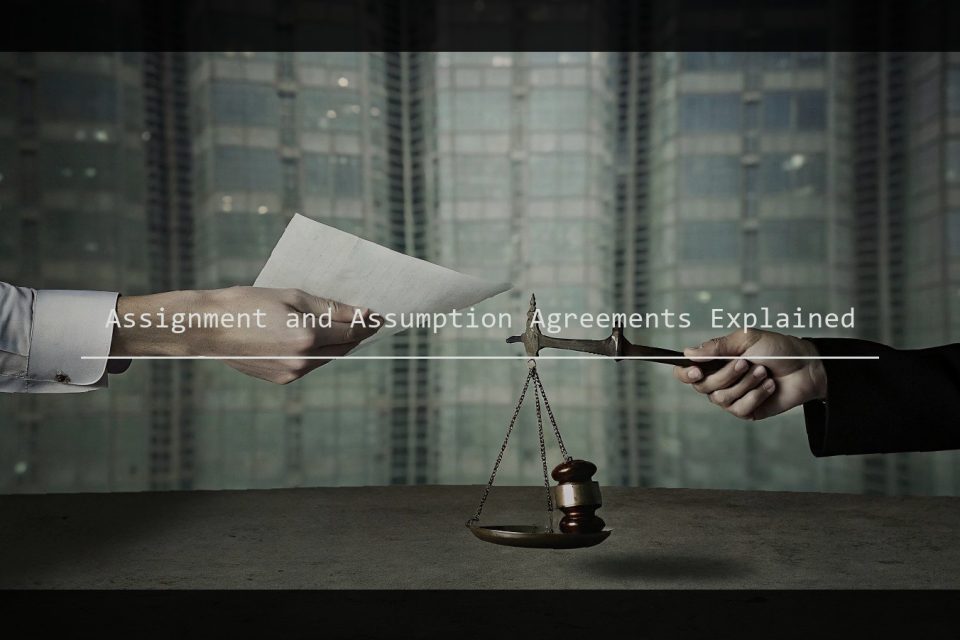What is an Assignment and Assumption Agreement?
An Assignment and Assumption agreement (sometimes abbreviated as "A&A") is a legal document that facilitates the transfer of rights and obligations from one party (the assignor) to another (the assignee). Contracts can be assigned in order to transfer the assignor’s contractual right to performance; however, an assignment must be for new consideration, such as money or other property. In other words, a party cannot simply assign a contract’s rights for free (although there can be exceptions). The assignee then assumes the performance obligation under the contract, and also acquires the original contracting party’s rights to performance. As a legal concept, "assignment" has been used in several contexts, such as assignment of error or assignment of benefits . However, in the business & corporate world, assignments usually refer to contractual assignments. Having a written assignment is significant for various reasons. For example, the original contracting party may want to terminate the contract and free itself from liability upon its assignment, and assigning parties may want to ensure the protection of their rights moving forward.
To be valid, the voluntary act of assigning a contract must satisfy the following requirements: Assignment of a contract is perhaps the simplest way to transfer rights and obligations, and is significantly simpler than the transfer of ownership. Assignments/Assumptions are often used with security agreements.
Key Elements of the Agreement
In general, the assignor is the company selling the asset. The assignee, on the other hand, is the entity acquiring the asset. The assignee assumes the liabilities to the assignor or a third party. For example, the assignor likely remains responsible for licensure. This is so even though the assignee might deal with the business thereafter. Say your business is a restaurant. Licensure might be the business license or a liquor license. The assignor and assignee can stipulate who is responsible for that license in the assignment and assumption agreement. The liability of the assignor may depend on the specific provisions in the agreement. For example, the agreement should contemplate indemnification by the assignor for losses arising from a breach of the agreement. This could include a breach of a representation or warranty in the agreement. A breach of contract claim might give rise to an indemnification obligation by the assignor. A clause requiring the assignor to indemnify the assignee is essential when the asset has pending litigation or other disputes. Questions around pending litigation often arise from the purchase of a restaurant or commercial retail development.
Assignment and Assumption Process
The entire process to effectuate an assignment and assumption agreement is a negotiated transaction subject to a lease’s specific provisions and the right of the landlord to approve the transaction. It is generally governed by the following steps:
- Notice. The tenant sends written notice to the landlord advising of its intent to assign or transfer. This notice should be in accordance with the provisions of its lease, if any, and must include sufficient detail for the landlord to review the propriety of the proposal. The proposed assignee will likely need a copy of the lease in order to review it with the tenant.
- Lease Transfer Terms. Lease terms regarding the transfer, including timing and consent conditions. The tenant and its proposed assignee will each want to review the lease terms with a good lawyer to make sure that the proposal is covered in the lease (to document the tenant’s rights and obligations) and then determine whether the tenant can assign or transfer without any consent and if so, whether and what, additional terms and conditions are called for. The landlord will want to review the particulars and the tenant’s landlord for consent.
- Assumption Agreement. The assumption agreement agreement itself should be in writing and should incorporate by reference the requirements of the lease, if any, as well as the fictitious name suggested above and any other special terms and conditions. It should also be signed by the landlord.
- Landlord’s Consent. The landlord’s consent to the assignment and assumption transaction will be in the form of a separate written instrument in ordinary course and usually is accompanied by additional required documentation that may be outlined in the lease document or separately requested by the landlord. The landlord’s approval usually contains various provisions protecting the landlord from any claims by the tenant on account of any assignee, and the tenant will be required to release the tenant from all liability.
Legal Issues and Considerations
The legal implications of assignment and assumption agreements can be significant. From the perspective of the assignor, it is imperative to have assurances that the assignee will honor the agreement and will abide by its terms. For the assignee, whether a person or an entity, an assignment and assumption agreement may present an opportunity to acquire rights and/or benefits that would not otherwise be available if the transaction was not structured in that way. A caveat emptor mentality must be exercised when implementing an assignment and assumption agreement, both from the perspective of assigning rights and/or obligations under a contract but also from the assumption of rights and/or obligations.
For example, if you are entering into an assignment and assumption agreement involving a lease, be sure to read the fine print in the contract. There may be certain rights that that are given up or that are in jeopardy if the assignment is not properly supported and approved. If you do not follow the terms of the lease or any other agreement, then you can create a situation where the original obligations and liabilities get sprung back on the assignor.
Potential legal disputes also exist. If the assignment and assumption agreement is poorly drafted, or if the underlying agreement contains vague language, then an opportunity may exist for the original parties to the agreement to argue about how the agreement was to work. In that type of scenario, you may find yourself in court defending an assignment and assumption agreement because the other party asserts that your interpretation or assertion is contrary to the intent of the agreement. In the alternative, if you are a party to the original agreement and the assignment and assumption is invalid, you could potentially be seeking an order declaring the contract to be void or seeking an award of damages for non-performance.
As with most things in life, there are risks involved with signing an assignment and assumption agreement. You should therefore thoroughly read the contract that you are assuming or assigning and consult with an attorney before proceeding with the transaction. Properly performed, an assignment and assumption agreement can be a blessing and a creative way to acquire and obtain rights and benefits. Alternatively, if not done correctly, it can create a potential legal landmine and put the parties in a surprisingly precarious position.
Recent Applications in Business Dealings
Assignment and assumption agreements play a pivotal role in a wide array of business transactions, including mergers, acquisitions, and the transfer of leases. They typically form-part of a more complex series of transaction documents, but their importance cannot be understated.
Mergers and Acquisitions. They are often employed in the context of mergers and acquisitions, where the parties are merging their separate legal identities and doing so through the conveyance of assets & liabilities. Crews v. Hdqtrs., LLC, 106 A.3d 1175 (Del. 2014). Plaintiffs in Crews alleged that "a leveraged buyout occurred when [Hqdrts] bought back 100% of the member interests held by [Paley and others]." Id. at 1187. The Court held that an assignment and assumption agreement was critical to a complete merger of two legal entities, because the agreement had to fulfill the statutory requirement that the liabilities of the merged company be "deemed the liabilities of the surviving company." Id . citing 8 Del. C. § 251(c) (emphasis in original).
Lease Assignments. Assignment and assumption agreements are also commonly found in the context of a commercial real estate transaction, where they are used to transfer the rights and obligations of a former tenant to a new tenant. Brandywine Operating Partners, LLC v. Counted Cross-Training, LLC, 2012 WL 1033556 (Del. Super. Ct. Mar. 27, 2012). In Brandywine, the Court denied a tenant’s motion for post-trial relief, under a formula where it must establish a manifest injustice "that could not have been raised by timely objection in the underlying action." It found plaintiff’s argument to be waived because "the release in the Assignment and Assumption [is] clear and unambiguous." Id. at 13. Brandywine makes clear that the clear and unambiguous language between two sophisticated parties will always be found controlling, unless it is proven that the parties were not sophisticated enough to know what they were signing.
Writing Tips and Common Guidelines
A well-drafted assignment and assumption agreement is crucial to ensuring that all parties fully understand their rights and responsibilities. While every assignment is different, some best practices should always be considered: When drafting an assignment and assumption agreement, it is important to remember that the goal is for each party to fully understand what is being transferred between them. Ambiguity and vagueness can lead to disputes over what exactly has transferred, how the transfer will take place, and what rights and responsibilities the parties have. Being aware of these potential pitfalls and drafting accordingly can help to avoid disputes, and ensure a smoother transition.
Answers to Common Questions
1. Why are assignment and assumption agreements needed?
Assignment and assumption agreements are a normal part of numerous real estate and business transactions, and are particularly important in the context of landlord-tenant relationships. They effectively serve to shift lease rights and obligations from the original lessee to a new one. A proper assignment or sublease eliminates any doubt under the lease as to the respective rights and responsibilities of the landlord and the eventual assignee or sublessee.
2. What is a sublease?
Sublease is the term used to describe an arrangement where a tenant leases a portion or all of its leased space from the landlord to a third-party subtenant. Subleases typically involve shorter terms and rental rates than the existing lease, but otherwise must comply with the terms of the original lease. When determining the ultimate rental rate for the subtenant, the tenant will typically attempt to take into consideration the current market rate for commercial real estate in the area, discounted for the earlier expiration of the sublease as well as for any potential difficulty in re-leasing the property.
3. When should an assignment or sublet be considered?
A tenant should consider assigning or subletting its leased space as part of its initial planning of its occupancy of the property. This will better prepare it for downsizing , early termination or lease expiration. Practically, a tenant should look at assigning or subleasing its leased space if it needs to resize or relocate its business, or to reduce costs.
4. Are subleases allowed?
Most commercial leases will allow for subleases, but only that sublease is approved by the landlord. A well-structured lease will require the tenant to submit a copy of the proposed sublease to the landlord for its review and approval, followed by execution of a sublease agreement that is acceptable to the tenant and landlord.
5. What should be included in assignment and assumption agreements?
Assignment and assumption agreements should clearly identify the parties to the agreement (the assignor, the assignee, the landlord and the tenant), the date on which the agreement is effective, and the purpose of the assignment. The agreements should be signed by all parties and must clearly and unambiguously indicate the intention of the parties to transfer rights and obligations. The agreements should also contain a list of the rights and obligations that are being transferred and identify when the transfer will take place.

